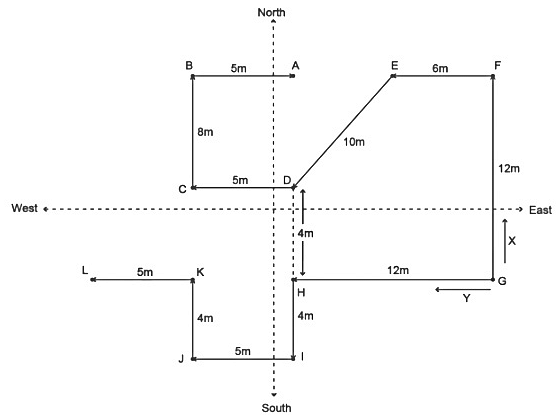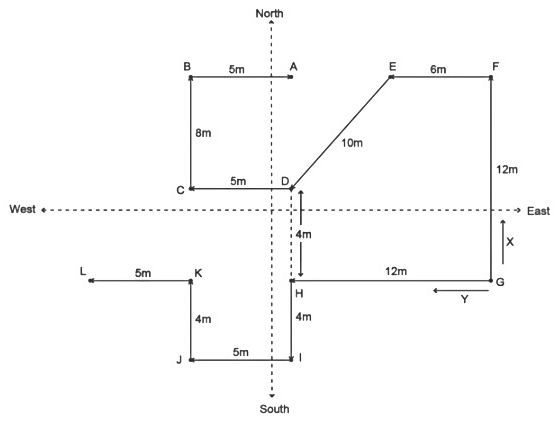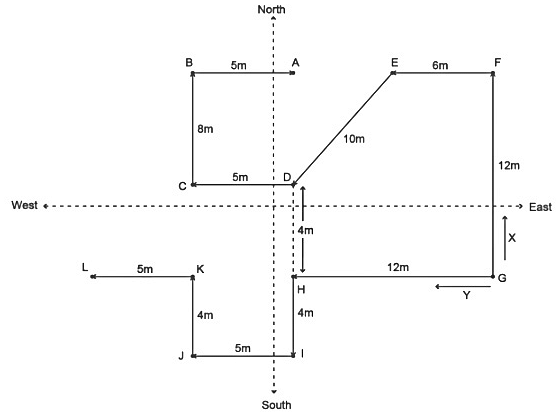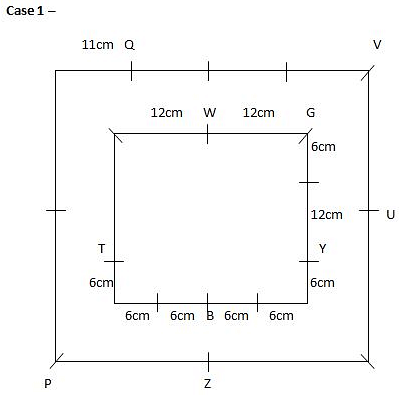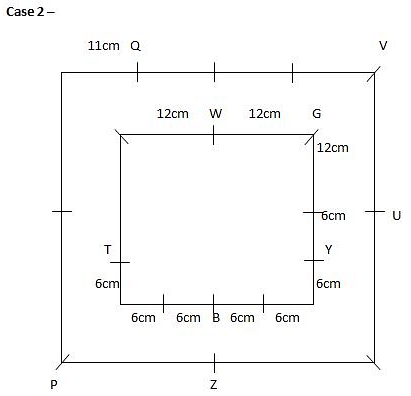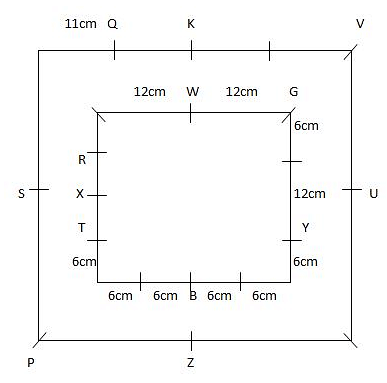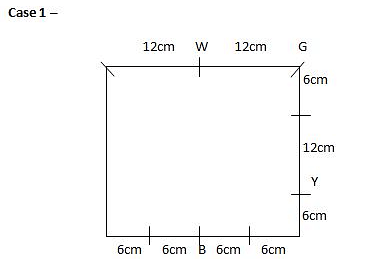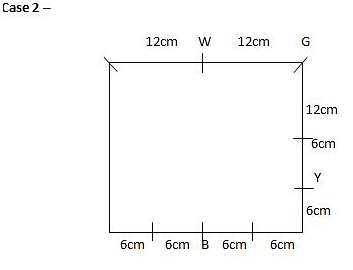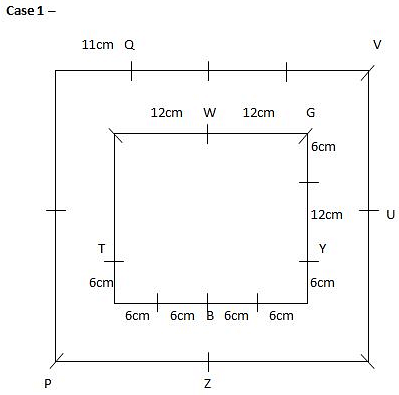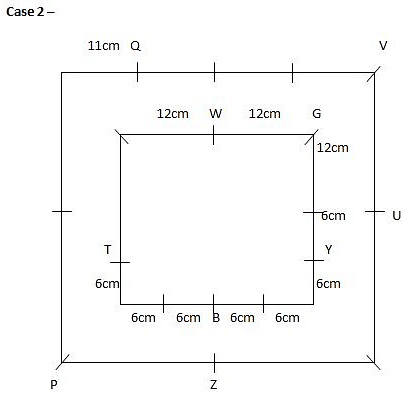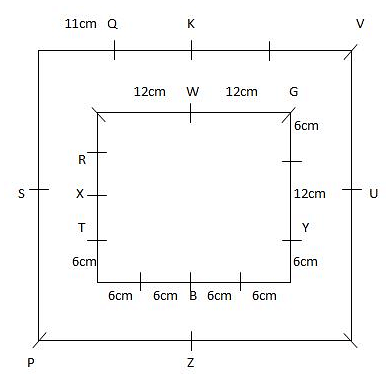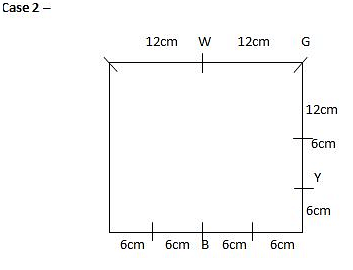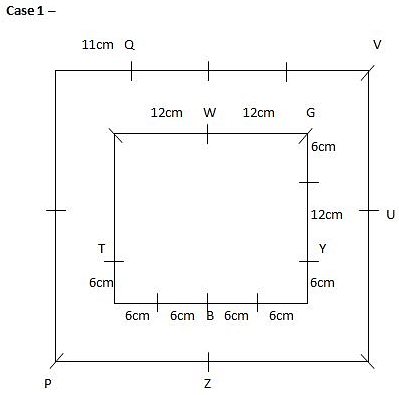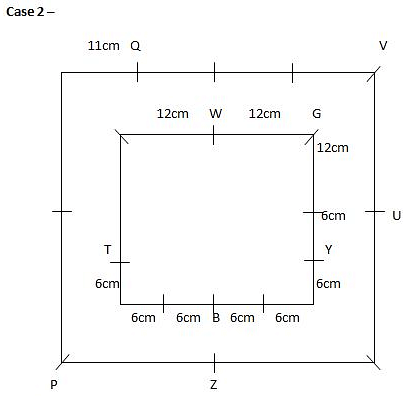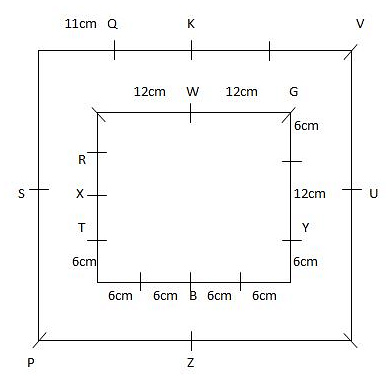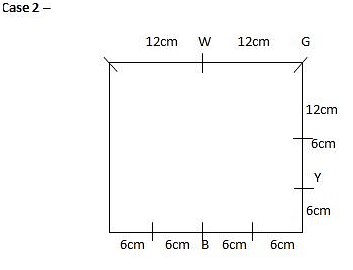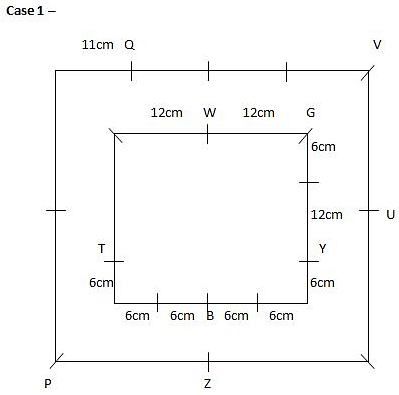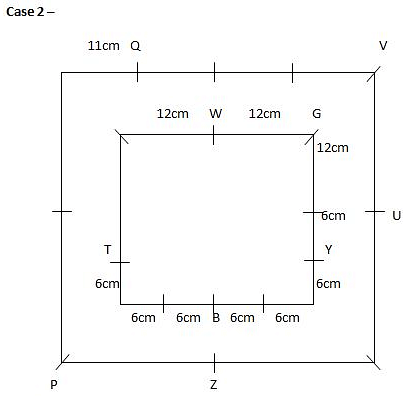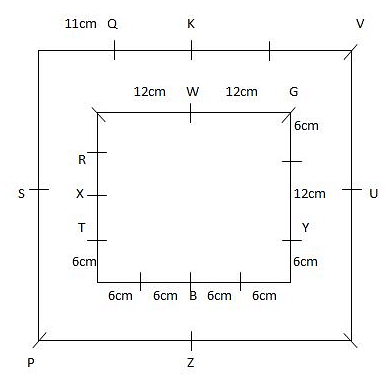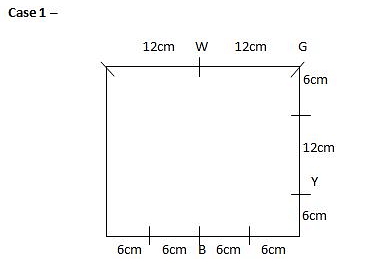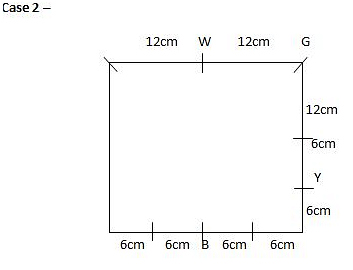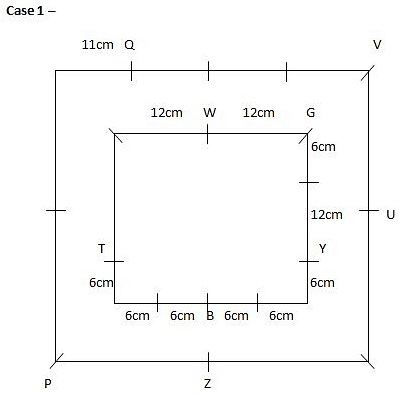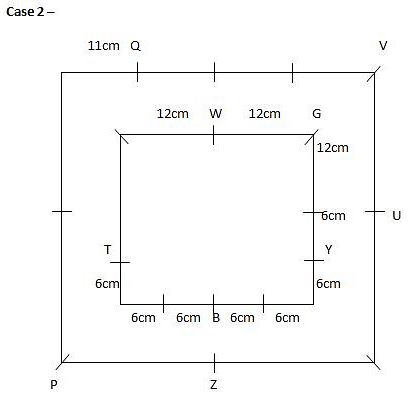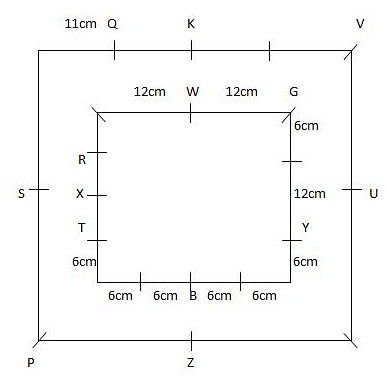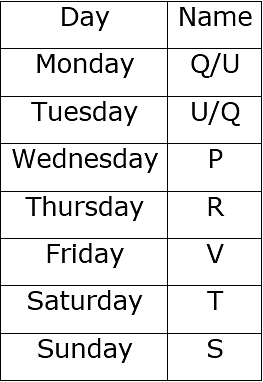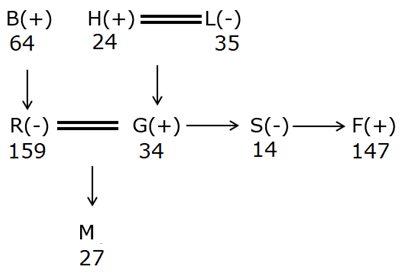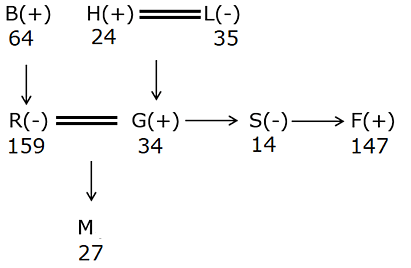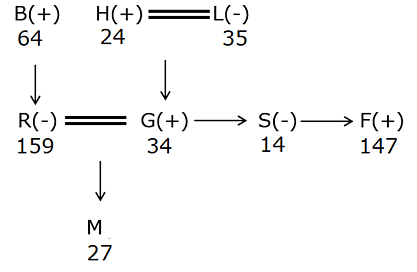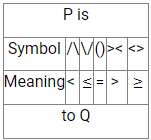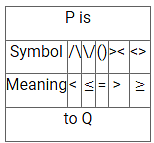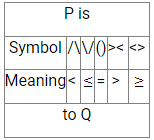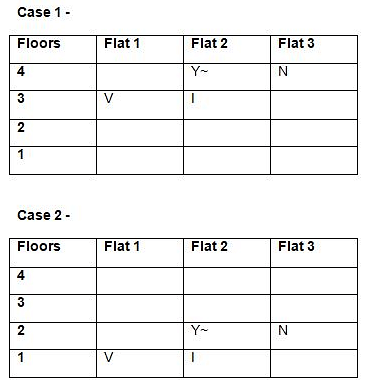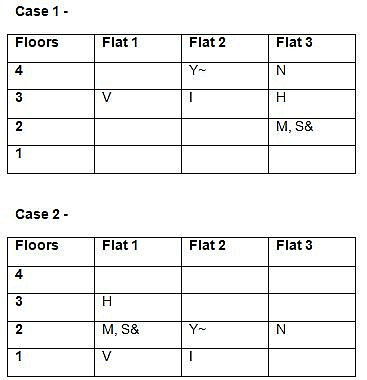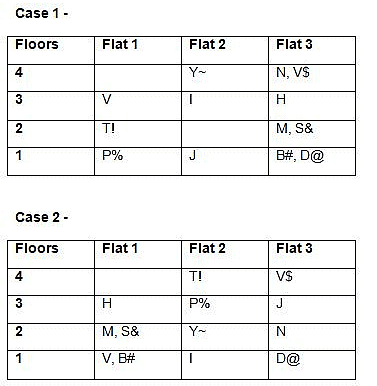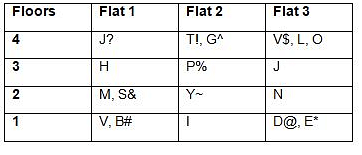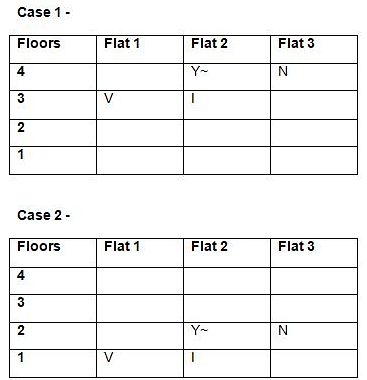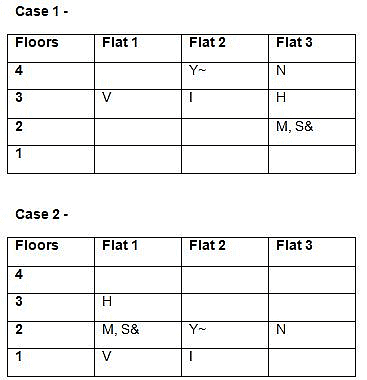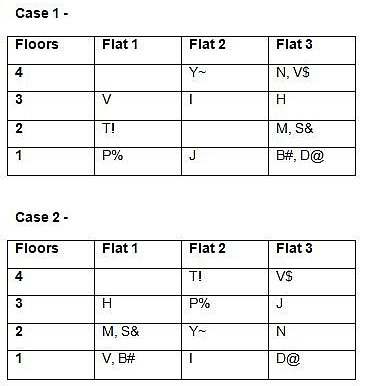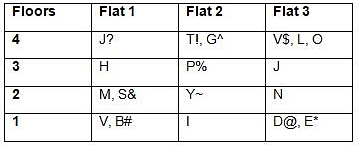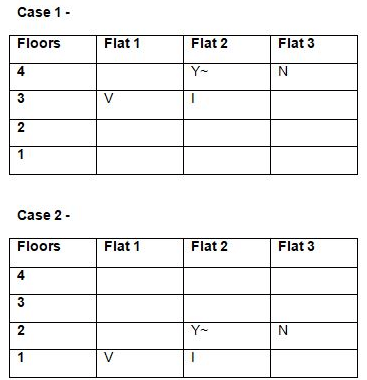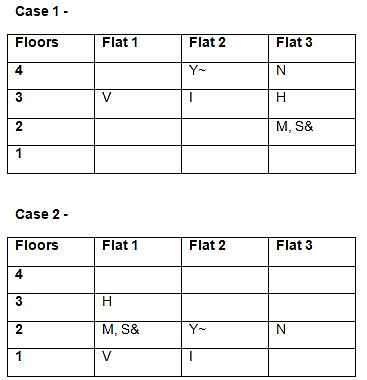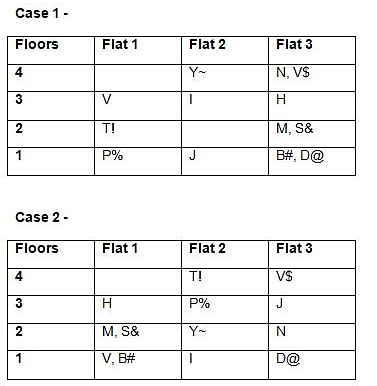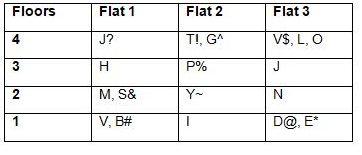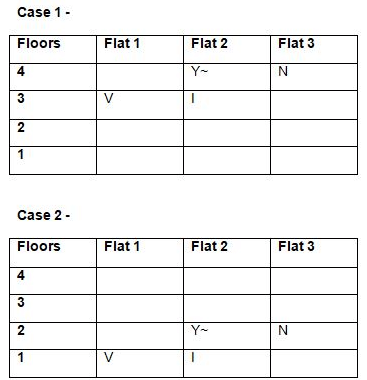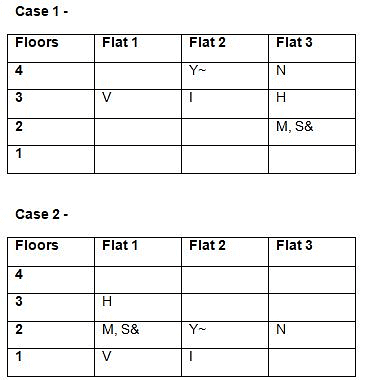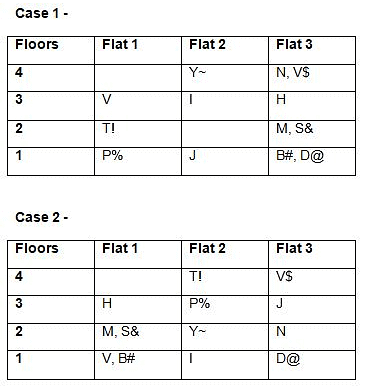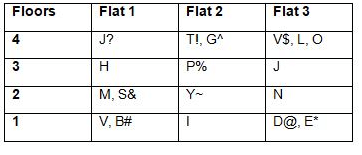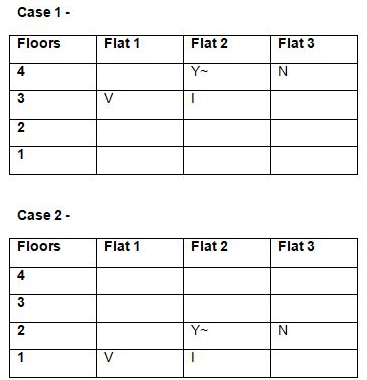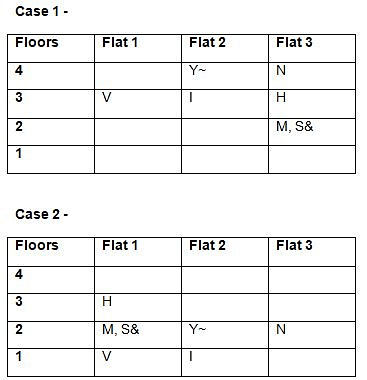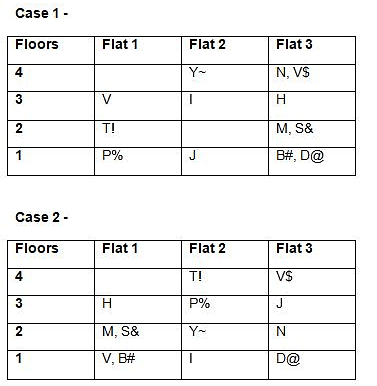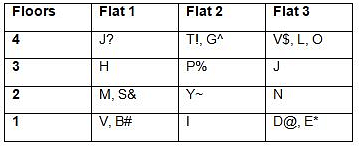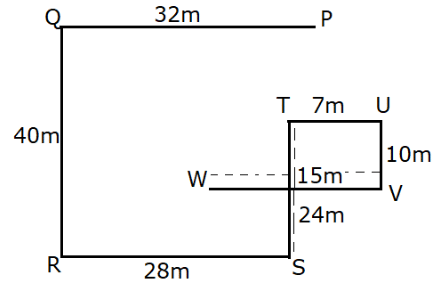SBI PO Mains Mock Test - 6 - Bank Exams MCQ
30 Questions MCQ Test Mock Tests for Banking Exams 2024 - SBI PO Mains Mock Test - 6
Study the following information carefully and decide which of the following statements from given columns are sufficient to answer the given question.
Eight boxes – A, B, C, D, E, F, G, and H are kept one above the other in a form of a stack. Which of the following box is kept immediately above D?
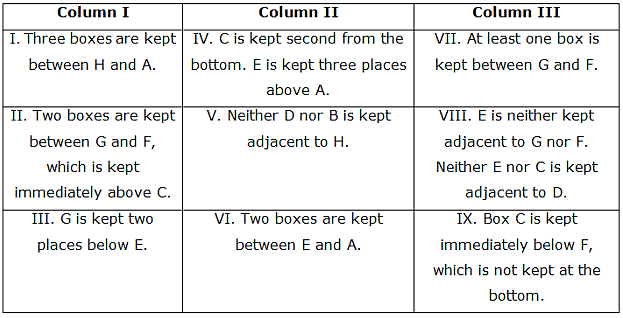

Direction: Study the information given below carefully and answer the question that follow.
Two persons X and Y starts from a point G. X moves 12 m in the north direction from point G. He then turns left from point F and walks 6 m. He then moves south-west from point E and walks 10 m till point D, which is in south of point A. X then moves 5 m west from point D and then turns right from point C and walks for 8 m. He then turns right from point B and walks for 5 m till point A. Point C is in north of point K. Y moves 12 m in west from point G. He then turns left from point H and walks for 4 m. He then turns right from point I and walks for 5 m. He then turns right from point J and walks for 4 m. He then turns left from point K and walks for 5 m till point L.
What is the shortest distance between point (A) and point E?
| 1 Crore+ students have signed up on EduRev. Have you? Download the App |
Direction: Study the information given below carefully and answer the question that follow.
Two persons X and Y starts from a point G. X moves 12 m in the north direction from point G. He then turns left from point F and walks 6 m. He then moves south-west from point E and walks 10 m till point D, which is in south of point A. X then moves 5 m west from point D and then turns right from point C and walks for 8 m. He then turns right from point B and walks for 5 m till point A. Point C is in north of point K. Y moves 12 m in west from point G. He then turns left from point H and walks for 4 m. He then turns right from point I and walks for 5 m. He then turns right from point J and walks for 4 m. He then turns left from point K and walks for 5 m till point L.
What is the shortest distance between D and H?
Direction: Study the information given below carefully and answer the question that follow.
Two persons X and Y starts from a point G. X moves 12 m in the north direction from point G. He then turns left from point F and walks 6 m. He then moves south-west from point E and walks 10 m till point D, which is in south of point A. X then moves 5 m west from point D and then turns right from point C and walks for 8 m. He then turns right from point B and walks for 5 m till point A. Point C is in north of point K. Y moves 12 m in west from point G. He then turns left from point H and walks for 4 m. He then turns right from point I and walks for 5 m. He then turns right from point J and walks for 4 m. He then turns left from point K and walks for 5 m till point L.
In which direction is point D with respect to point H?
Study the following information carefully and answer the below questions.
Certain number of persons are sitting around the two square tables facing the centre of the table. One square table is inscribed inside another table. The area of inner table is 576cm2. The perimeter of outer table is 176cm. Maximum three persons sit around each side. The distance between any two adjacent persons on any side around outer table is either 11cm or 22cm. The distance between any two adjacent persons on any side around inner table is either 6cm or 12cm. Persons can sit on each side or corner. Only two persons sit at the corners of inner table. Three persons sit on the corners of outer table. Distance between any two persons are calculated only around the perimeter of the square. No seat is vacant. Number of persons around inner square is 2 more than number of persons around outer square.
Immediate neighbours of B are 6cm away from him. W is adjacent to both the persons who sits at the corners. Z is second person to the left of U, who is not adjacent to P. One person sits in the middle of each side of outer square. T sits opposite to Y around the same table. R is immediate left of X, who is not opposite to anyone around inner square.
K is second person to the left of S in outer square. Y is 18cm to the right of B who sits in the middle of the side. Z and U sit in the middle of one of the sides. V and P sit opposite to each other. R and X sit on the same side. Y is second person to the left of G, who sits at one of the corners. V sits nearest and opposite to G’s seat. W and B are opposite to each other around the same table. P is 55 cm to the right of Q. V is third person to the left of Q. Z and V are not adjacent to each other. No one sits between W and G when counted from the left of W.
Who sits fourth to the right of G?
Study the following information carefully and answer the below questions.
Certain number of persons are sitting around the two square tables facing the centre of the table. One square table is inscribed inside another table. The area of inner table is 576cm2. The perimeter of outer table is 176cm. Maximum three persons sit around each side. The distance between any two adjacent persons on any side around outer table is either 11cm or 22cm. The distance between any two adjacent persons on any side around inner table is either 6cm or 12cm. Persons can sit on each side or corner. Only two persons sit at the corners of inner table. Three persons sit on the corners of outer table. Distance between any two persons are calculated only around the perimeter of the square. No seat is vacant. Number of persons around inner square is 2 more than number of persons around outer square.
Immediate neighbours of B are 6cm away from him. W is adjacent to both the persons who sits at the corners. Z is second person to the left of U, who is not adjacent to P. One person sits in the middle of each side of outer square. T sits opposite to Y around the same table. R is immediate left of X, who is not opposite to anyone around inner square.
K is second person to the left of S in outer square. Y is 18cm to the right of B who sits in the middle of the side. Z and U sit in the middle of one of the sides. V and P sit opposite to each other. R and X sit on the same side. Y is second person to the left of G, who sits at one of the corners. V sits nearest and opposite to G’s seat. W and B are opposite to each other around the same table. P is 55 cm to the right of Q. V is third person to the left of Q. Z and V are not adjacent to each other. No one sits between W and G when counted from the left of W.
Who sits fifth to the right of Z?
Study the following information carefully and answer the below questions.
Certain number of persons are sitting around the two square tables facing the centre of the table. One square table is inscribed inside another table. The area of inner table is 576cm2. The perimeter of outer table is 176cm. Maximum three persons sit around each side. The distance between any two adjacent persons on any side around outer table is either 11cm or 22cm. The distance between any two adjacent persons on any side around inner table is either 6cm or 12cm. Persons can sit on each side or corner. Only two persons sit at the corners of inner table. Three persons sit on the corners of outer table. Distance between any two persons are calculated only around the perimeter of the square. No seat is vacant. Number of persons around inner square is 2 more than number of persons around outer square.
Immediate neighbours of B are 6cm away from him. W is adjacent to both the persons who sits at the corners. Z is second person to the left of U, who is not adjacent to P. One person sits in the middle of each side of outer square. T sits opposite to Y around the same table. R is immediate left of X, who is not opposite to anyone around inner square.
K is second person to the left of S in outer square. Y is 18cm to the right of B who sits in the middle of the side. Z and U sit in the middle of one of the sides. V and P sit opposite to each other. R and X sit on the same side. Y is second person to the left of G, who sits at one of the corners. V sits nearest and opposite to G’s seat. W and B are opposite to each other around the same table. P is 55 cm to the right of Q. V is third person to the left of Q. Z and V are not adjacent to each other. No one sits between W and G when counted from the left of W.
How many persons sit between R and B when counted from the left of R?
Study the following information carefully and answer the below questions.
Certain number of persons are sitting around the two square tables facing the centre of the table. One square table is inscribed inside another table. The area of inner table is 576cm2. The perimeter of outer table is 176cm. Maximum three persons sit around each side. The distance between any two adjacent persons on any side around outer table is either 11cm or 22cm. The distance between any two adjacent persons on any side around inner table is either 6cm or 12cm. Persons can sit on each side or corner. Only two persons sit at the corners of inner table. Three persons sit on the corners of outer table. Distance between any two persons are calculated only around the perimeter of the square. No seat is vacant. Number of persons around inner square is 2 more than number of persons around outer square.
Immediate neighbours of B are 6cm away from him. W is adjacent to both the persons who sits at the corners. Z is second person to the left of U, who is not adjacent to P. One person sits in the middle of each side of outer square. T sits opposite to Y around the same table. R is immediate left of X, who is not opposite to anyone around inner square.
K is second person to the left of S in outer square. Y is 18cm to the right of B who sits in the middle of the side. Z and U sit in the middle of one of the sides. V and P sit opposite to each other. R and X sit on the same side. Y is second person to the left of G, who sits at one of the corners. V sits nearest and opposite to G’s seat. W and B are opposite to each other around the same table. P is 55 cm to the right of Q. V is third person to the left of Q. Z and V are not adjacent to each other. No one sits between W and G when counted from the left of W.
What is the shortest distance between Q and U?
Study the following information carefully and answer the below questions.
Certain number of persons are sitting around the two square tables facing the centre of the table. One square table is inscribed inside another table. The area of inner table is 576cm2. The perimeter of outer table is 176cm. Maximum three persons sit around each side. The distance between any two adjacent persons on any side around outer table is either 11cm or 22cm. The distance between any two adjacent persons on any side around inner table is either 6cm or 12cm. Persons can sit on each side or corner. Only two persons sit at the corners of inner table. Three persons sit on the corners of outer table. Distance between any two persons are calculated only around the perimeter of the square. No seat is vacant. Number of persons around inner square is 2 more than number of persons around outer square.
Immediate neighbours of B are 6cm away from him. W is adjacent to both the persons who sits at the corners. Z is second person to the left of U, who is not adjacent to P. One person sits in the middle of each side of outer square. T sits opposite to Y around the same table. R is immediate left of X, who is not opposite to anyone around inner square.
K is second person to the left of S in outer square. Y is 18cm to the right of B who sits in the middle of the side. Z and U sit in the middle of one of the sides. V and P sit opposite to each other. R and X sit on the same side. Y is second person to the left of G, who sits at one of the corners. V sits nearest and opposite to G’s seat. W and B are opposite to each other around the same table. P is 55 cm to the right of Q. V is third person to the left of Q. Z and V are not adjacent to each other. No one sits between W and G when counted from the left of W.
How many persons sit in the inner arrangement?
Study the following information carefully and decide which of the following statements from given columns are sufficient to answer the given question.
Seven persons – P, Q, R, S, T, U, and V visited a place during a week starting from Monday to Sunday but not necessarily in the same order. Who among the following person visited immediately before T?
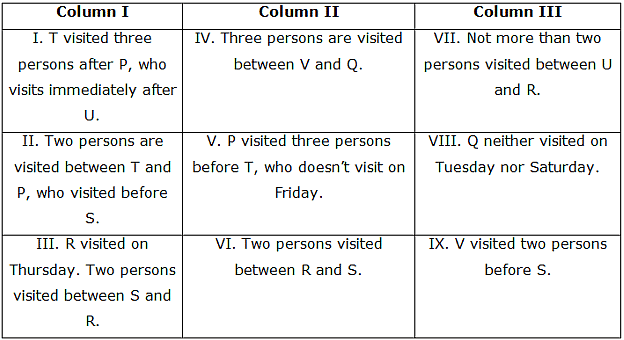
Direction: The International Monetary Fund (IMF) forecasted an increase in growth rate for India in the following years. If the projections are taken into the account, then by the upcoming year India would surpass China as the world’s fastest-growing major economy.
China is currently the world’s fastest-growing major economy.
In the question given below consists of a statement, followed by two arguments numbered I and II. You have to decide which of the arguments is a 'strong' argument and which is a 'weak' argument.’
Strong’ arguments are one which are both important and directly related to the question.
‘Weak’ arguments are those which are of minor importance and also may not be directly related to the question or may be related to trivial aspect of the question.
Statement: Many schools are having to do away with their music education programs. This is a mistake, with schools losing not only an enjoyable subject, but a subject that can enrich students’ lives and education.
Which of the following steps weakens the above thoughts?
(I) Students who have early musical training will develop the areas of the brain related to language and reasoning. The left side of the brain is better developed with music, and songs can help imprint information on young minds.
(II) The programs for foreign language learning or legitimate computer programming classes at a young age would help provide our children with more value in the future since they shall always be in demand.
(III) There aren't many musicians that make more than 100k a year, while there are many engineers who do.
Study the following information carefully and answer the below questions.
In a family of eight members – B, F, G, H, L, M, R, and S. Two married couples are there in the family. Each person has different number of toffees. M has 504 toffees initially. M takes 27 toffees and gives the remaining toffees to his mother R. R’s father-in-law is married to L. S is the only daughter of L. R takes 1/3rd of the toffees and gives the remaining toffees to her father-in-law. S’s father takes 24 toffees and gives the remaining toffees to F, who is an unmarried member. F takes 2/3rd of the toffees and gives the remaining toffees to his brother G. G gives 64 toffees to his father-in-law B. F gives 1/4th of his toffees to his sister, who gives 35 toffees to his mother.
How the one who has 14 toffees is related to M?
Study the following information carefully and answer the below questions.
In a family of eight members – B, F, G, H, L, M, R, and S. Two married couples are there in the family. Each person has different number of toffees. M has 504 toffees initially. M takes 27 toffees and gives the remaining toffees to his mother R. R’s father-in-law is married to L. S is the only daughter of L. R takes 1/3rd of the toffees and gives the remaining toffees to her father-in-law. S’s father takes 24 toffees and gives the remaining toffees to F, who is an unmarried member. F takes 2/3rd of the toffees and gives the remaining toffees to his brother G. G gives 64 toffees to his father-in-law B. F gives 1/4th of his toffees to his sister, who gives 35 toffees to his mother.
How the one who has 147 toffees is related to H?
Study the following information carefully and answer the below questions.
In a family of eight members – B, F, G, H, L, M, R, and S. Two married couples are there in the family. Each person has different number of toffees. M has 504 toffees initially. M takes 27 toffees and gives the remaining toffees to his mother R. R’s father-in-law is married to L. S is the only daughter of L. R takes 1/3rd of the toffees and gives the remaining toffees to her father-in-law. S’s father takes 24 toffees and gives the remaining toffees to F, who is an unmarried member. F takes 2/3rd of the toffees and gives the remaining toffees to his brother G. G gives 64 toffees to his father-in-law B. F gives 1/4th of his toffees to his sister, who gives 35 toffees to his mother.
What is the sum of the number of toffees does M’s father and H’s wife have?
Direction: In the following questions, the symbols /\, \/, <>, >< and () are used with the following meaning as illustrated below:
‘P /\ Q’ means ‘P is neither greater than nor equal to Q’.
‘P \/ Q’ means ‘P is not greater than Q’.
‘P () Q’ means ‘P is neither smaller than nor greater than Q’
‘P >< Q’ means P is greater than Q’.
‘P <> Q’ means ‘P is not smaller than Q.
Now in each of the following questions assuming the given statements to be true, find which of the conclusion/s given below them is/are definitely true?
Statements:
R <> S, S >< Q, R <> T, P \/ Q
Conclusions:
I. R >< P
II. S () T
III. R >< Q
Direction: In the following questions, the symbols /\, \/, <>, >< and () are used with the following meaning as illustrated below:
‘P /\ Q’ means ‘P is neither greater than nor equal to Q’.
‘P \/ Q’ means ‘P is not greater than Q’.
‘P () Q’ means ‘P is neither smaller than nor greater than Q’
‘P >< Q’ means P is greater than Q’.
‘P <> Q’ means ‘P is not smaller than Q.
Now in each of the following questions assuming the given statements to be true, find which of the conclusion/s given below them is/are definitely true?
Statements:
C () B, C \/ D, A /\ C, E \/ F, B >< E
Conclusions:
I. B \/ D
II. F /\ B
III. C /\ D
Direction: In the following questions, the symbols /\, \/, <>, >< and () are used with the following meaning as illustrated below:
‘P /\ Q’ means ‘P is neither greater than nor equal to Q’.
‘P \/ Q’ means ‘P is not greater than Q’.
‘P () Q’ means ‘P is neither smaller than nor greater than Q’
‘P >< Q’ means P is greater than Q’.
‘P <> Q’ means ‘P is not smaller than Q.
Now in each of the following questions assuming the given statements to be true, find which of the conclusion/s given below them is/are definitely true?
Statements:
F <> I, E >< G, H /\ I, F ( ) G
Conclusions:
I. G ( ) I
II. F <> E
III. G >< I
Study the following information carefully and answer the question given below-
A certain number of persons are living in a building having four floors. Also each of the floor having three flats such as flat-2 is in east of flat-1 but west of flat-3. Ground floor is numbered floor 1 and top most floor is floor 4. Each flat is built in such a way that Flat 1 of floor 2 is just above Flat 1 of floor 1 and just below flat-1 of floor-3 and so on. Only the given persons are considered to be living in the building. No flat is vacant. No two floors having same number of persons living in it. J is not living on even numbered floor. E* is living in a flat just below the flat of N. Y~ is living on an even numbered floor and he is living immediate west of N. No one lives to the east to O. M is living with only S& in same flat which is immediately below the flat of H. Two floors are there between the floors on which D@ and V$ lives and both are living in the same flat number. G^ is not living alone in any of the flat. The total number of persons living on topmost floor is one more than the number of persons living on the bottom most floor. G^ is living immediate west of O. I is living immediately below Y~ in the same flat number. V is living immediate west of I. Number of persons living on floor-2 is more than the number of persons living on floor-3 but less than number of persons living on floor-1. H is living on a floor having least number of persons. J? is living to the west of L. Only one floor is there between H and B# who is living in same flat number as H. No one is living to the east of D@ who lives below V$. P% is living in a flat which is just below the flat of T!. No one is living with P% and is living immediate west of J. No one is living with J?. O is living on even numbered floor. No one is living with H in the same flat. L is not living in the same flat with T!.
Who among the following is living on floor 4 of flat 1?
Study the following information carefully and answer the question given below-
A certain number of persons are living in a building having four floors. Also each of the floor having three flats such as flat-2 is in east of flat-1 but west of flat-3. Ground floor is numbered floor 1 and top most floor is floor 4. Each flat is built in such a way that Flat 1 of floor 2 is just above Flat 1 of floor 1 and just below flat-1 of floor-3 and so on. Only the given persons are considered to be living in the building. No flat is vacant. No two floors having same number of persons living in it. J is not living on even numbered floor. E* is living in a flat just below the flat of N. Y~ is living on an even numbered floor and he is living immediate west of N. No one lives to the east to O. M is living with only S& in same flat which is immediately below the flat of H. Two floors are there between the floors on which D@ and V$ lives and both are living in the same flat number. G^ is not living alone in any of the flat. The total number of persons living on topmost floor is one more than the number of persons living on the bottom most floor. G^ is living immediate west of O. I is living immediately below Y~ in the same flat number. V is living immediate west of I. Number of persons living on floor-2 is more than the number of persons living on floor-3 but less than number of persons living on floor-1. H is living on a floor having least number of persons. J? is living to the west of L. Only one floor is there between H and B# who is living in same flat number as H. No one is living to the east of D@ who lives below V$. P% is living in a flat which is just below the flat of T!. No one is living with P% and is living immediate west of J. No one is living with J?. O is living on even numbered floor. No one is living with H in the same flat. L is not living in the same flat with T!.
How many persons are living to the west of ‘I’?
Study the following information carefully and answer the question given below-
A certain number of persons are living in a building having four floors. Also each of the floor having three flats such as flat-2 is in east of flat-1 but west of flat-3. Ground floor is numbered floor 1 and top most floor is floor 4. Each flat is built in such a way that Flat 1 of floor 2 is just above Flat 1 of floor 1 and just below flat-1 of floor-3 and so on. Only the given persons are considered to be living in the building. No flat is vacant. No two floors having same number of persons living in it. J is not living on even numbered floor. E* is living in a flat just below the flat of N. Y~ is living on an even numbered floor and he is living immediate west of N. No one lives to the east to O. M is living with only S& in same flat which is immediately below the flat of H. Two floors are there between the floors on which D@ and V$ lives and both are living in the same flat number. G^ is not living alone in any of the flat. The total number of persons living on topmost floor is one more than the number of persons living on the bottom most floor. G^ is living immediate west of O. I is living immediately below Y~ in the same flat number. V is living immediate west of I. Number of persons living on floor-2 is more than the number of persons living on floor-3 but less than number of persons living on floor-1. H is living on a floor having least number of persons. J? is living to the west of L. Only one floor is there between H and B# who is living in same flat number as H. No one is living to the east of D@ who lives below V$. P% is living in a flat which is just below the flat of T!. No one is living with P% and is living immediate west of J. No one is living with J?. O is living on even numbered floor. No one is living with H in the same flat. L is not living in the same flat with T!.
Who among the following lives just below ‘S&’ in the same flat number?
Study the following information carefully and answer the question given below-
A certain number of persons are living in a building having four floors. Also each of the floor having three flats such as flat-2 is in east of flat-1 but west of flat-3. Ground floor is numbered floor 1 and top most floor is floor 4. Each flat is built in such a way that Flat 1 of floor 2 is just above Flat 1 of floor 1 and just below flat-1 of floor-3 and so on. Only the given persons are considered to be living in the building. No flat is vacant. No two floors having same number of persons living in it. J is not living on even numbered floor. E* is living in a flat just below the flat of N. Y~ is living on an even numbered floor and he is living immediate west of N. No one lives to the east to O. M is living with only S& in same flat which is immediately below the flat of H. Two floors are there between the floors on which D@ and V$ lives and both are living in the same flat number. G^ is not living alone in any of the flat. The total number of persons living on topmost floor is one more than the number of persons living on the bottom most floor. G^ is living immediate west of O. I is living immediately below Y~ in the same flat number. V is living immediate west of I. Number of persons living on floor-2 is more than the number of persons living on floor-3 but less than number of persons living on floor-1. H is living on a floor having least number of persons. J? is living to the west of L. Only one floor is there between H and B# who is living in same flat number as H. No one is living to the east of D@ who lives below V$. P% is living in a flat which is just below the flat of T!. No one is living with P% and is living immediate west of J. No one is living with J?. O is living on even numbered floor. No one is living with H in the same flat. L is not living in the same flat with T!.
Who among the following lives just below P% in the same flat number?
Study the following information carefully and answer the question given below-
A certain number of persons are living in a building having four floors. Also each of the floor having three flats such as flat-2 is in east of flat-1 but west of flat-3. Ground floor is numbered floor 1 and top most floor is floor 4. Each flat is built in such a way that Flat 1 of floor 2 is just above Flat 1 of floor 1 and just below flat-1 of floor-3 and so on. Only the given persons are considered to be living in the building. No flat is vacant. No two floors having same number of persons living in it. J is not living on even numbered floor. E* is living in a flat just below the flat of N. Y~ is living on an even numbered floor and he is living immediate west of N. No one lives to the east to O. M is living with only S& in same flat which is immediately below the flat of H. Two floors are there between the floors on which D@ and V$ lives and both are living in the same flat number. G^ is not living alone in any of the flat. The total number of persons living on topmost floor is one more than the number of persons living on the bottom most floor. G^ is living immediate west of O. I is living immediately below Y~ in the same flat number. V is living immediate west of I. Number of persons living on floor-2 is more than the number of persons living on floor-3 but less than number of persons living on floor-1. H is living on a floor having least number of persons. J? is living to the west of L. Only one floor is there between H and B# who is living in same flat number as H. No one is living to the east of D@ who lives below V$. P% is living in a flat which is just below the flat of T!. No one is living with P% and is living immediate west of J. No one is living with J?. O is living on even numbered floor. No one is living with H in the same flat. L is not living in the same flat with T!.
How many persons live above J in the same flat?
If 1st letter of each word from (I) group, 2nd letter of each word from (II) group, 3rd letter of each word from (III) group are taken to form a single meaningful 6 letter word, then which of the following is the third letter from the left end of the newly formed word? If no such word is formed, mark your answer as ‘X’, or else if more than one word is formed; mark your answer as ‘M’.
I. PEN LAME
II. INK THEN
III. PRICE PIT
Direction: Read the following information carefully and answer the question asked below:
% R 9 W 2 7 C # 1 O 5 Q & 8 D E 2 6 * 3 K 7 ! P A M 4 ^
Step I: Numbers are interchanged with immediately preceded elements in the series.
Step II: The letter which is immediately preceded by a number to be arranged in alphabetical order immediately after the last element of the series.
Step III: Multiples of 3 are interchanged with first letter occurring after them in the series.
Step IV: Perfect cubes interchanged with succeeding elements in the series.
Note: Step 2 is performed after the completion of step 1 and step 3 is performed after the completion of step 2 and so on.
How many numbers are there between the sixth element from the left and ninth element from the right in step IV?
Direction: Read the following information carefully and answer the question asked below:
% R 9 W 2 7 C # 1 O 5 Q & 8 D E 2 6 * 3 K 7 ! P A M 4 ^
Step I: Numbers are interchanged with immediately preceded elements in the series.
Step II: The letter which is immediately preceded by a number to be arranged in alphabetical order immediately after the last element of the series.
Step III: Multiples of 3 are interchanged with first letter occurring after them in the series.
Step IV: Perfect cubes interchanged with succeeding elements in the series.
Note: Step 2 is performed after the completion of step 1 and step 3 is performed after the completion of step 2 and so on.
Which among the following is immediate left of the tenth from the left in step I?
Direction: Read the following information carefully and answer the question asked below:
% R 9 W 2 7 C # 1 O 5 Q & 8 D E 2 6 * 3 K 7 ! P A M 4 ^
Step I: Numbers are interchanged with immediately preceded elements in the series.
Step II: The letter which is immediately preceded by a number to be arranged in alphabetical order immediately after the last element of the series.
Step III: Multiples of 3 are interchanged with first letter occurring after them in the series.
Step IV: Perfect cubes interchanged with succeeding elements in the series.
Note: Step 2 is performed after the completion of step 1 and step 3 is performed after the completion of step 2 and so on.
What is the sum of the numbers which are present between ‘&’ and ‘^’ in step III?
Direction: Read the following information carefully and answer the question asked below:
% R 9 W 2 7 C # 1 O 5 Q & 8 D E 2 6 * 3 K 7 ! P A M 4 ^
Step I: Numbers are interchanged with immediately preceded elements in the series.
Step II: The letter which is immediately preceded by a number to be arranged in alphabetical order immediately after the last element of the series.
Step III: Multiples of 3 are interchanged with first letter occurring after them in the series.
Step IV: Perfect cubes interchanged with succeeding elements in the series.
Note: Step 2 is performed after the completion of step 1 and step 3 is performed after the completion of step 2 and so on.
Which among the following is third from the right of fifth from the left after the completion of all the steps?
In a competition, Raiyansh got more scores than Mahi but not as many as Pooja. Pooja got more scores than Gautam and Karan. Gautam got less scores than Mahi but this scores are not the lowest in the group. Who is second in the descending order of scores?
Study the following information carefully and answer the following questions.
“P@Q(12)” means “P is 16m north of Q”.
“P%Q(14)” means “P is 17m west of Q”.
“P&Q(21)” means “P is 17m south of Q”.
“P#Q(18)” means “P is 15m east of Q”.
Condition: Q@R(36), R%S(25), P#Q(35), S&T(28), U#T(10), W%V(12), V&U(14)
What is the shortest distance and direction of T with respect to P?
|
160 tests
|



